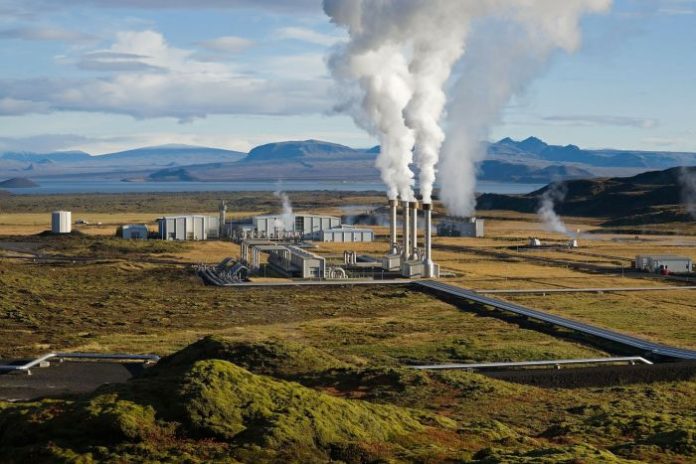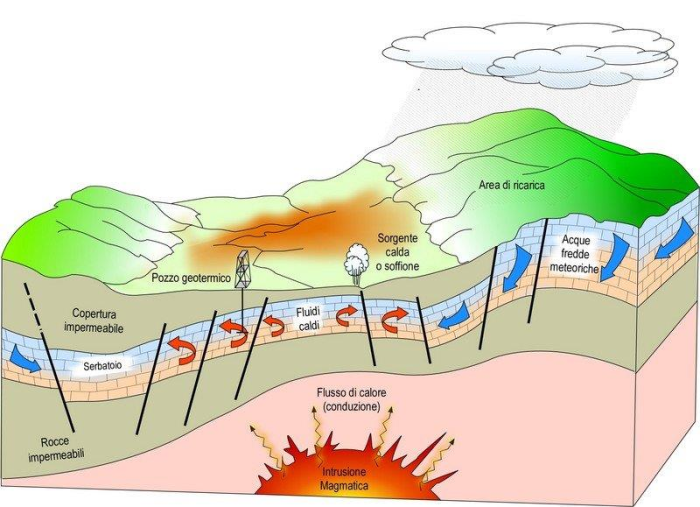
The geothermal energy is a possible source of provisions, using the inner heat of the Earth and reprenents an effective option Geothermal energy is a possible source of energy supply that exploits the Earth’s internal heat and is, in certain geological conditions, a valid alternative to fossil fuels. In general, and especially in Italy, when we talk about renewable energy and sustainability we think almost exclusively of wind, solar and biomass; geothermal energy, on the other hand, never seems to be considered a valid alternative (though not the only one) in a national energy policy plan.
Yet it was in Italy, precisely in Larderello (Pisa), that pioneering technologies were developed to produce electricity from geothermal steam (1904), and in 1911 the world’s first geothermal power plant was built, capable of generating electricity on an industrial scale, which at the time powered not only the town of Larderello in Tuscany, but also the entire city of Volterra. Tuscany is the region that represents geothermal energy not only in Italy but in Europe, hosting today the largest thermoelectric plant on the continent at Larderello, as well as some thirty other plants in the provinces of Siena, Pisa and Grosseto. In addition, Italy has a world-leading industrial sector that works almost exclusively on research projects and exploitation of this energy source abroad.
What are the characteristics of a geothermal system?
A prerequisite for the exploitation of geothermal heat in an area is its geological structure. In general, the planet releases heat continuously from its interior (core) to the outside, and depending on the different geological structures present, there is a geothermal gradient, which expresses the variation of temperature with depth. On average, the temperature increases with depth by 2.5-3 °C every 100 metres, but it is clear that this flow is much higher in the presence of, for example, active (young) volcanic areas and/or areas with a very thin earth’s crust (continental rifting and oceanic areas). However, heat loss in the subsurface is very high and influenced by many factors, so it is not sufficient to go deep enough to have a potential geothermal resource. It is necessary to have three components, which generally identify a traditional hydrothermal system:
- a source of heat, understood as subterranean heat that becomes elevated when there is a magmatic body cooling within the crust;
- a geothermal reservoir, consisting of hot, fracture-permeable rocks or rock formations;
- a fluid circulating in the reservoir rocks, such as groundwater, i.e. rainwater that infiltrates and percolates into the permeable rocks where it is heated.
To avoid heat dispersion, geothermal systems are closed upwards by an impermeable covering (clay rocks), insulating the reservoir and preventing the rapid dispersion of heat towards surface. On the basis of fluid temperatures, it could be possible to classify in medium-high enthalpy systems (energy proportional to fluid temperature), as the major Italian resources, characterised by deep circuits with high temperatures (deep geothermics, with temperature greater than 150-190 °C).
However, research into new technologies now makes it possible to consider the subsoil in general as a thermal reservoir. In this case the thermal stability of the subsoil is exploited, i.e. the fact that at moderate depths the temperature is not affected by daily and/or seasonal fluctuations (as in cellars, where the temperature is cooler in summer and relatively warmer in winter than the outside air); in this case geothermal resources are classified as low enthalpy, with temperatures below 90 °C and are also referred to as surface geothermal resources.
A further chance adding to the traditional geothermal resources is the hydrofracturing of Hot Dry Rocks (also without a real geothermal reservoir), injecting high pressure cold water in depth, to crack a potential geothermal reservoir and adsorb heat within the permeabilized rocks. This technique was tested in lots of worldwide countries and was defined Enhanced Geothermal Systems (EGS), or rather third generation systems increasing the thermoelectric power plant’s performance and allowing to install a power station also in locations without a real geothermal reservoir. In this case it’s used the normal thermal gradient, producing an artificial deep fluids circulation and extracting heat at defined depths.
Geothermal fluids are the thermal energy carrier towards surface and were used both as a vapour phase (gas with medium-high enthalpy and so high temperatures) both as liquid phase (low enthalpy and low temperatures) respectively for thermoelectric production and for heat production in several applications. In Italy and in other regions, also anciently geothermal energy was used for thermal and health and more recently for thermoelectrical production (only for high enthalpy systems); other applications are air-conditioning of buildings, industries, in farming greenhouses, aquaculture and several industry processes, through heat pumps and district heating using low enthalpy resources. Regarding the energy request and for minimizing energy scattering, a geothermal plant is characterised by deep well systems thanks to which it’s possible to collect geothermal waters and at the same time to re-inject cold waters (after cooling) into the system. This for integrating the natural recharge by meteoric waters, always affected by climate factors.

What are the advantages and disadvantages of geothermal energy?
Geothermal energy is considered a renewable, clean and practically inexhaustible source of energy, as the ‘internal heat’ component of the planet is practically perennial, considering a time scale based on human life. The environmental impact is practically zero in terms of emissions, as there is no production of CO2 or fine dust (as there is no combustion); it is an energy source that is independent of the climatic factor (solar, wind…) and is able to produce 24 hours a day, guaranteeing better yield and continuity of operation. Thanks to technological advances in the sector, it is possible to produce electricity and heat at the same time (co-production) and/or to plan “cascade” uses, integrating different techniques capable of exploiting the resource at progressively lower temperatures.
But as with all energy sources, there are disadvantages that must be mentioned. For example, in terms of renewability, geothermal energy in the medium and long term requires certain considerations: the fluids involved are rainwater that recharges the natural system by infiltrating at depth; therefore, if the rate of extraction/exploitation of the resource is greater than the rate of recharging of the natural system, it is depleted, even though it is a renewable source. In addition, excessive groundwater extraction without replacement at depth leads to a problem of induced subsidence, without considering that geothermal water is often chemically enriched in toxic substances due to the interaction of gas-water-rock at high temperatures (e.g. boric water…), posing a problem of disposal.
One of the solutions currently being adopted is the technique of re-injecting process water at depth, both to mitigate the problems of induced subsidence and to improve the yield of recharging the system, as well as to partially solve the problems of disposing of potentially toxic water.
In addition, it must be considered that the heating process at depth is not immediate, so a certain amount of time is needed to allow the reservoir rocks to transmit the heat to the fluids, which is not always in accordance with production requirements. Some disadvantages can be linked to the initial costs of drilling (with the risks associated with such operations) as well as to an environmental impact that in some cases is due to the bad smells that can be released from the plants (which can be completely resolved, however, with monitoring systems and chemical abatement).
Italy is an extraordinary region from both a geological and a volcanological point of view, where different geodynamic conditions coexist (subduction of the Adriatic plate with arc volcanism, oceanisation of the Tyrrhenian Sea, crustal thinning of the western part of the peninsula), thanks to which geothermal exploration, which had great impetus during the oil crisis (1976) and until the 1990s, has revealed great potential.
At least 4 macro-areas have been identified, corresponding to:
- Tuscany, from Larderello to the Bolsena caldera (northern Latium), with a NW extension into the Ligurian Sea;
- Campi Flegrei in Campania
- Southern Tyrrhenian Sea, close to the volcanic arc of the Aeolian Islands;
- Sicily Channel, from the submarine volcano of Empedocle to Lampedusa.
State-subsidised exploration in this sector came to a halt in the 1990s, when the oil crisis receded and drilling came to a halt, halting all research and development (on a national scale). The climate crisis, the ever-increasing energy ‘thirst’ and the ecological transition impose on a geothermally hot country like Italy a massive resumption of studies, but above all of projects for the exploitation of resources, giving greater prominence to our world excellence in the sector and seeking to achieve energy independence or at least a reduced dependence on non-domestic fossil resources.



































